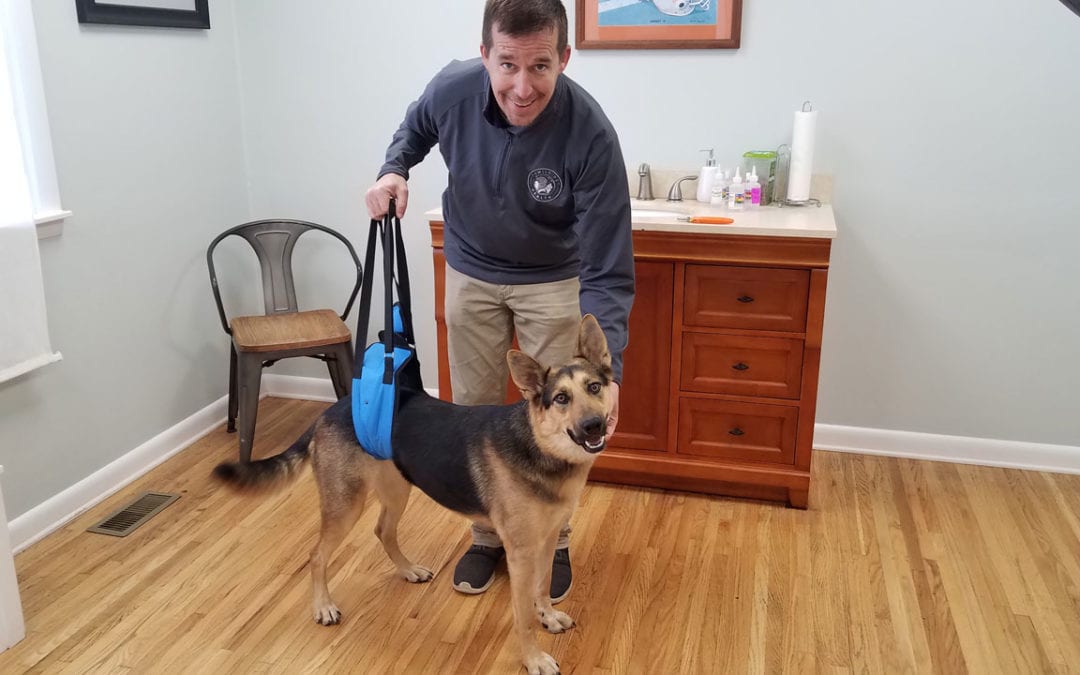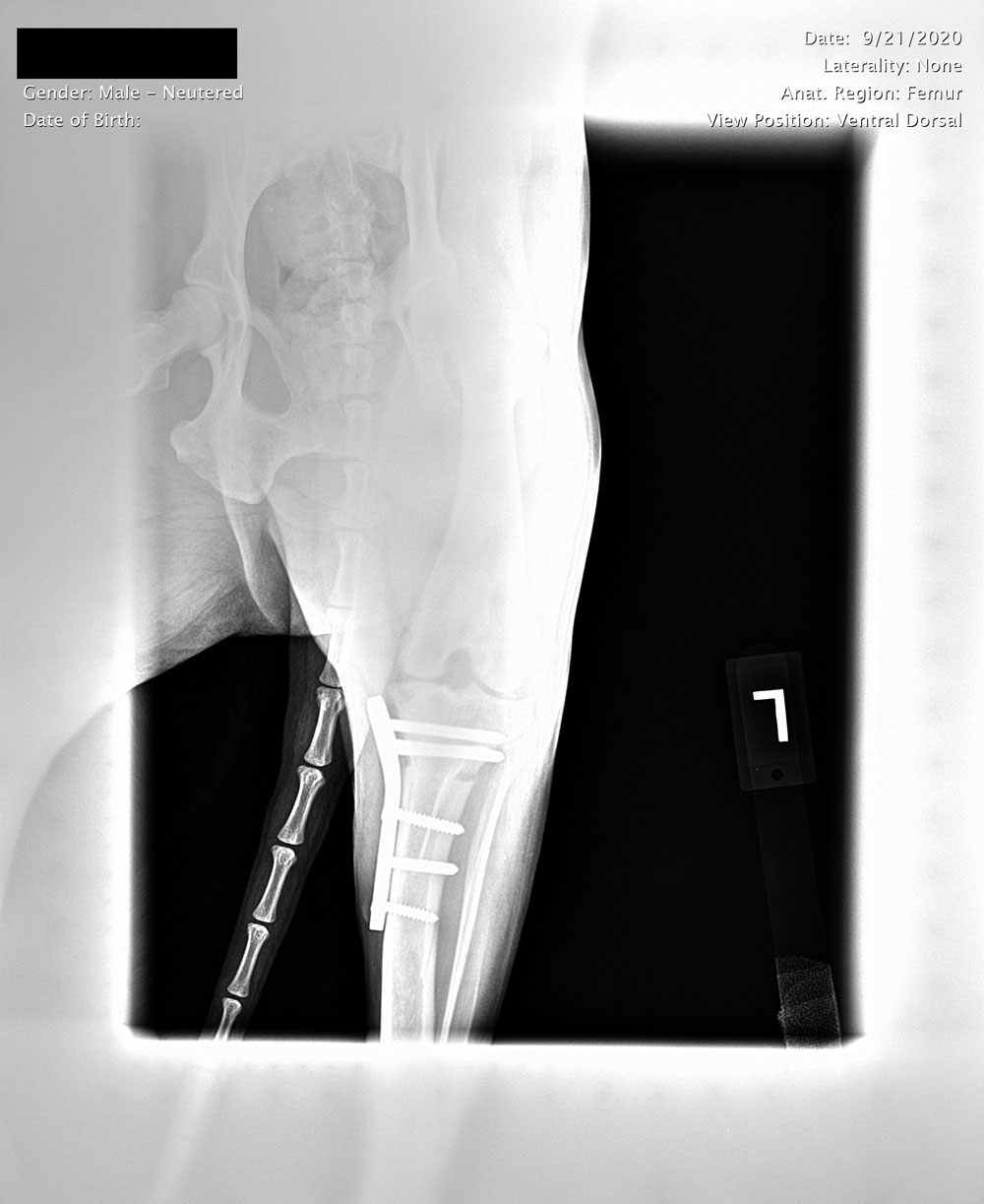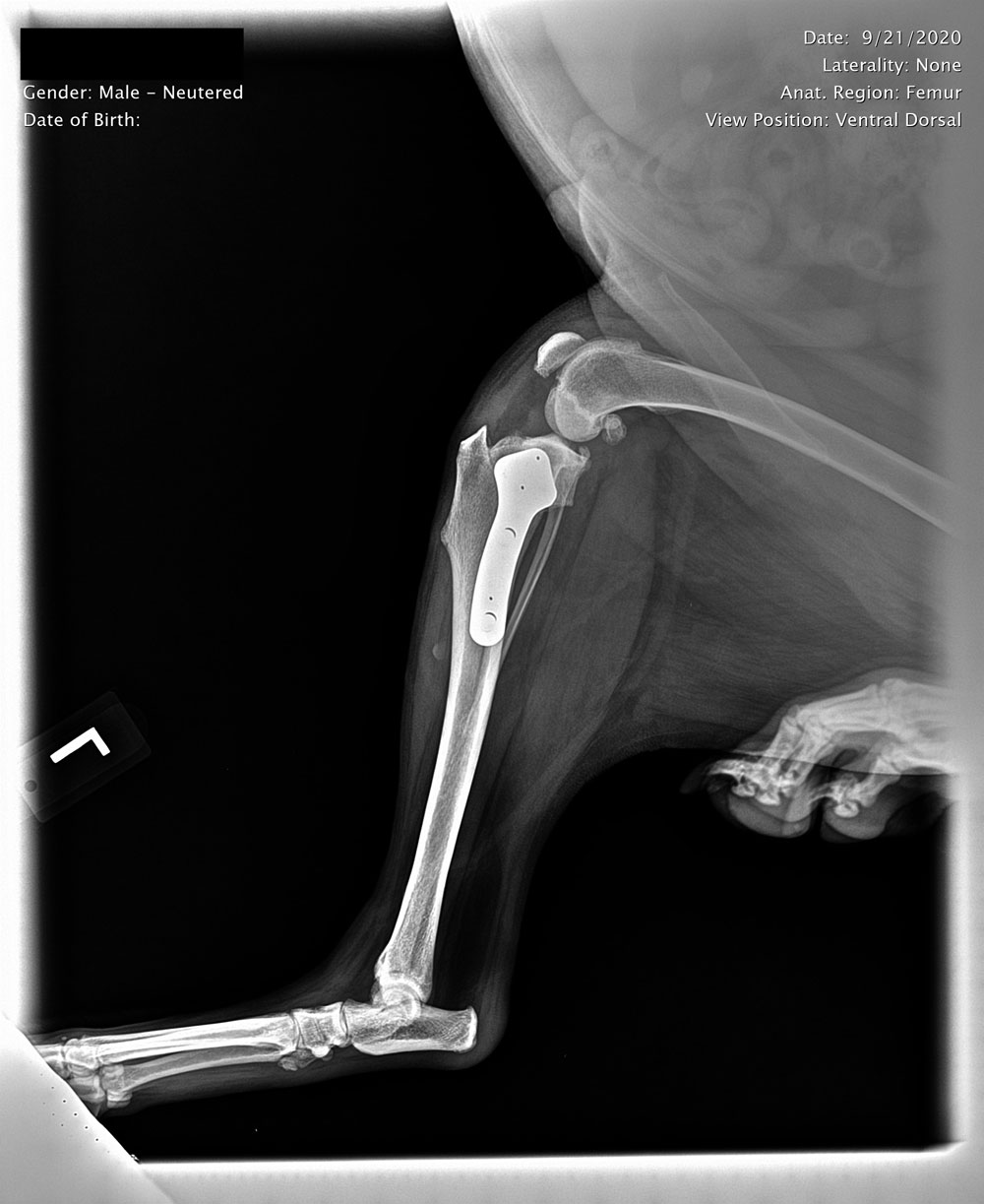Did you know that one of the most common serious injuries veterinarians see in large dogs is also a common human injury?
Tears of the Cranial Cruciate Ligament (CCL) in dogs is equivalent to injuries to the Anterior Cruciate Ligament (ACL) in humans. This ligament in the hind end of the dog sits between the femur (thigh) and the tibia (shin) bones and acts as a shock absorber, bearing a large load of the dogs weight, and helps position the dogs hind quarters correctly. Just like in humans, this ligament is susceptible to tearing or rupturing.
The injury can be sudden, like when your dog is running after a ball and suddenly comes back to you limping, or it can be caused by wear and tear as your pet ages. Factors like obesity, conformation (skeletal build) and breed can also play a role in CCL tears.
What are some signs your pet might have a CCL tear?
Your pet may have some swelling in the inside of the leg. Lameness, anywhere from mild to severe, may also be noted. The classic presentation is a “toe touch” limp where the injured leg is held mostly up off the ground, only touching the toes to the ground enough to allow the dog to walk.
Our veterinarians may diagnose a CCL injury by a “drawer test” in which the doctor will slide the joint back and forth. A lot of motion in the joint can be an indication of a tear. To confirm the diagnosis, the veterinarian will need to take x-rays of the joint. Your pet will need to be under sedation to perform these x-rays as the dog must be completely still and the hind limbs moved in ways that would be uncomfortable for an awake patient. The veterinarian is looking for fluid, any bone fragments that might have broken with the rupture or arthritis that may build up around an injury. This helps determine the extent of the damage caused by the rupture.
What’s next?
If your pet is diagnosed with a CCL tear some decisions will need to be made with the veterinary team. If the tear is minor, you may decide to treat it with extensive rest (3-6 weeks) and medications that will reduce inflammation and pain to make your dog more comfortable. This is most often effective in dogs that are smaller (less than 30 pounds) and are at a healthy weight and physical condition to begin with. Larger dogs and dogs that are obese are often not as successful with the rest and wait method. These dogs are most often surgical candidates.
The surgery that is commonly offered is called a TPLO, which stands for Tibial Plateau Leveling Osteotomy. This is a procedure that essentially changes the physics of the leg, making the ligament unneeded for stability of the knee. The surgeon makes cuts to the bone, rotates it, and then uses screws and a plate to provide stability. While there are a few other procedures, the TPLO remains the standard of care for this injury.
Due to the complexity of a TPLO, it is recommended to have a Board Certified Veterinary Surgeon perform your pet’s surgery. Here at Family Pet Health, we partner with Tennessee Veterinary Surgical Specialists. Their team of such specialists travel and perform the surgery here in our building rather than hosting patients in their own facilities. This eliminates long transportation requirements and reduces fear, anxiety and stress for your pet as they are already used to our facility.
Your dog had surgery – now what?
Immediately following your dog’s TPLO surgery, a set of post-op x-rays will be performed to ensure proper placement of screws and plates. Your dog will stay one night at our clinic, and the morning after the surgery the veterinary team will medicate and assess your pet. Once your pet is assessed and cleared, your pet will be discharged to recover at home. Our veterinarians will see your pet back in 6 weeks for another set of x-rays to ensure all is healing well. During those six weeks your pet will need to rest as much as possible while he or she heals. Activity should be limited to leash walking only for elimination purposes.
Data shows that 40-60% of dogs who experience a CCL tear will have similar issues in the other knee. It is crucial to their future health to keep your dog at a healthy weight to prevent further injury. However, once the injured knee is repaired, there is a 90% success rate with the TPLO surgery.
Pet owners who would like more information about common pet injuries or to have their own pet evaluated for a possible CCL tear can speak to one of our pet specialists here at Family Pet Health by calling 615-907-8387.
TPLO Case Study
Tina, an 11 year old mixed breed canine, was presented to Family Pet Health to Dr. Amy Shirley on July 3, 2020. She came to clinic limping and not bearing weight on her left hind leg. This had been a slight problem on sporadic occasions before but on June 29, she began not bearing weight for several days and came into the clinic that following Friday.
Dr. Shirley examined Tina and through her exam was able to diagnose her cranial cruciate ligament tear. Diagnosis was done through a positive drawer test in her left stifle with a grade of 4/4, along with her tibial thrust test. The patient displayed signs of discomfort during the tests, then was sedated for X-rays following the physical exam for continued diagnosis. Following the exam and sedation, the patient was prescribed Carprofen for pain and inflammation along with Phycox max as a joint supplement.
Cranial cruciate ligament tears can occur in both an acute or chronic manner depending on the patient. Chronic onset is most commonly seen and is shown typically in dogs ages 5-7 but acute injuries are also possible and most common in dogs under the age of 4. Chronic onset occurs due to the weakening of the fibers in the ligament leading to an eventual tear. (3)
Surgery was scheduled for the thirteenth of July and was determined that the TPLO surgery would be most effective for her condition. There are several surgeries practiced with a CCL tear, but the most common is the tibial plateau leveling osteotomy. This surgery was developed by Dr. Barclay Slocum over 20 years ago, and makes the ligament unneeded for the stability of the knee by changing the angulation and physics of the knee. Another method performed in association to a CCL tear on dogs less than 25 pounds is called an extra capsular repair technique or ECR. This method involves using a suture like material to stabilize the joint and prevent the tibia from sliding back and forth. Although this is the oldest method of treatment, it has been shown to be less successful on medium to large size dogs, therefore making the TPLO a better option of treatment. (4) (5)
The TPLO surgery was performed by the Tennessee Veterinary Surgical Specialists. (2)
The surgical specialist reviewed the patients radiographs to measure the tibial plateau angle and determine the cut needed to level the tibial plateau between 5 and 7 degrees. They began the surgery by opening and evaluating the stifle joint of the patient and addressed any other damaged ligaments or menisci at this point. The patient did display a tear so they performed a partial meniscectomy on the medial meniscus. They then continued by using a bone saw to disassociate the proximal tibia from the distal tibia. After the cut was made, they rotated the proximal section of the tibia to level the tibial plateau angle and secured it with a specialized bone plate and screws. The joint was palpated and confirmed stable prior to closing.
Following the surgery, post operative radiographs were performed and confirmed the success of the surgery. The leg was then bandaged and the patient stayed overnight at the clinic. Post-op medications included carprofen for pain and inflammation, cefpodoxime as an antibiotic and trazadone as a sedative. The patient was instructed to perform multiple daily range of motion exercises along with strict activity limits for the 8 week recovery period. A suture removal and recheck was performed 2 weeks post op and the patient had a great increase in mobility. The patient was walking and bearing almost complete weight on the left hind leg. Tina will return in another 6 weeks for her last round of radiographs to confirm correct healing of the bone.
Sources
https://tplonashville.com/
http://www.tnvetsurgery.com/procedures
https://www.uvsonline.com/cranial-cruciate-ligament-rupture/
https://www.topdoghealth.com/library/orthopedic-surgery/articles-surgery/tibial-plateau-leveling-osteotomy-tplo/
https://www.dispomed.com/tplo-surgery-in-dogs-success-rates-and-alternatives/




